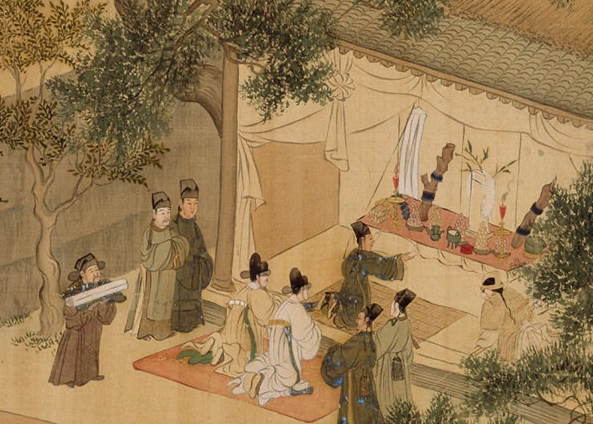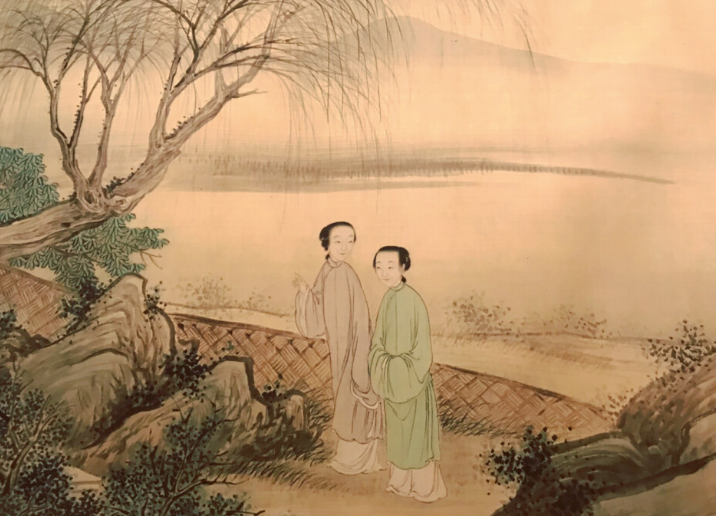Hanfu styles evolved through eras, like Tang’s flamboyant wide sleeves, symbolizing each dynasty’s cultural ethos.
Hanfu in Ancient Dynasties
Shang and Zhou Dynasties
The evolution of Hanfu, a quintessential element of Chinese culture, traces its roots back to the Shang and Zhou dynasties. These periods lay the groundwork for what would become a significant cultural identity marker. Initially, Hanfu took on a simple yet elegant form, reflecting the societal norms and rituals of the era. Garments typically comprised a Yi, a narrow-cuffed, knee-length tunic, and a Chang, a narrow, ankle-length skirt. Interestingly, both men and women donned these garments, with only minor stylistic differences.
A major innovation of this era was the introduction of the Shenyi, a garment combining the Yi and the Chang. This design echoed the Chinese values of harmony and unity, prevalent in many aspects of their culture. Silk, the primary material used, underscored China’s advancements in sericulture and became a symbol of wealth and nobility. The intricate patterns and motifs on these silk garments displayed an extraordinary level of artisanal skill.

Qin and Han Dynasties
As we journey into the Qin and Han dynasties, Hanfu undergoes a significant transformation. This period marks the establishment of the Classical Hanfu, setting a standard that would influence Chinese attire for centuries to come. The Han dynasty, in particular, is pivotal in this evolution. The Hanfu from this era symbolizes elegance and simplicity, mirroring the Han dynasty’s commitment to Confucian restraint and propriety.
A key garment of this time was the Ru, a shirt or jacket worn over the Yi. Made of lighter materials, the Ru bore subtle yet sophisticated patterns. The Ku, a type of trousers, offered more mobility compared to the Chang, reflecting the dynamic Han lifestyle. The introduction of the Po, an overcoat for colder seasons, showed the versatility of Hanfu in adapting to different climates.
Advancements in textile production and dyeing techniques during this era led to a diverse range of colors and fabrics in Hanfu. The use of colors held deep symbolic meanings rooted in Chinese philosophy. For example, blue and green symbolized spring, while white was associated with mourning. This period also saw the democratization of Hanfu, making it more accessible to the common people, albeit in simpler designs and less expensive materials.
The craftsmanship and intricate detailing in the Hanfu of the Qin and Han dynasties are monumental, solidifying its status as an emblem of Chinese culture, ethics, and aesthetics. The Classical Hanfu, known for its distinct silhouette and refined elegance, remains a celebrated icon of Chinese heritage.
The Flourishing of Hanfu in the Golden Ages
Sui and Tang Dynasties
The Sui and Tang dynasties heralded a golden age for Hanfu, marking an era of unparalleled diversity and innovation in traditional Chinese attire. These periods witnessed the blending of cultural influences due to the Silk Road, which brought an infusion of fresh ideas, fabrics, and styles. The Tang dynasty, in particular, is renowned for its cosmopolitan spirit, which significantly influenced Hanfu designs. Women’s attire during this period, known for its flamboyant and liberal styles, featured wide sleeves, high waists, and the use of sheer fabrics like silk gauze, bringing a sense of elegance and femininity to the forefront.
Men’s Hanfu also underwent remarkable changes, with the adoption of round-neck robes and the popularization of Shenyi, which became more elaborate during this time. The Tang dynasty’s prosperity led to an explosion of color in Hanfu, moving beyond the traditional color palette to include vibrant hues like purples and reds. This era also saw the use of intricate embroidery and patterns, often depicting natural scenes and mythical creatures, reflecting the Tang dynasty’s love for art and nature.
Song Dynasty
As the baton passed to the Song dynasty, Hanfu experienced a significant transition, aligning more with the dynasty’s emphasis on refinement and subtlety. This era is characterized by a return to more conservative styles, in contrast to the flamboyant Tang fashions. The Song dynasty’s Hanfu showcased a preference for more fitted and modest designs, mirroring the period’s philosophical and cultural ethos. For instance, women’s dresses often featured a high-waisted, narrow-sleeved shirt known as the Beizi, which became a symbol of Song dynasty elegance.
The Song dynasty’s advancements in weaving and dyeing techniques brought about improvements in fabric quality and variety. Silk, while still predominant, was now available in lighter and more comfortable weaves, suitable for the dynasty’s understated aesthetic. Men’s attire during the Song dynasty was equally refined, with a preference for straight robes and simple lines, reflecting the scholarly and bureaucratic nature of Song society.
The Song dynasty also marks a period where Hanfu started to diverge regionally, adapting to local climates and cultural preferences. This diversification signifies the adaptability of Hanfu, making it not just a national symbol, but also a reflection of regional identities within China.
Later Dynastic Developments in Hanfu
Yuan Dynasty
The Yuan Dynasty, marking the Mongol rule, brought a unique blend to Hanfu, intertwining Mongolian and Han cultures. This era introduced styles significantly distinct from traditional Hanfu. High collars and narrow sleeves, characteristic of Mongolian attire, became prevalent. The Han Chinese maintained their cultural identity by wearing traditional Hanfu in private.
The Yuan Dynasty’s Hanfu distinguished itself through the integration of Mongolian and other ethnic designs. Fabrics adapted to the colder northern climates, becoming heavier, a shift from the traditional silk. Cotton started to gain popularity, appreciated for its practicality and comfort. Despite the Yuan’s brief rule, their influence on Hanfu left an indelible mark, introducing elements that resonated in future styles.
Ming Dynasty
The Ming Dynasty witnessed a deliberate revival of traditional Hanfu styles, reasserting Han cultural identity after Yuan’s rule. This period is often viewed as a renaissance of Hanfu, reconnecting with the elegance of Tang and Song dynasty styles. The Ming Hanfu was known for its symmetry and straight lines, epitomizing elegance and simplicity.
Women’s Hanfu typically featured the Ao, a centrally fastened jacket, accompanied by a long skirt. Men favored the Daopao, a wide-sleeved long robe, reflecting the dynasty’s scholarly values. Silk, embellished with intricate patterns symbolizing good fortune or longevity, re-emerged as the fabric of choice.
The Ming Dynasty also introduced new garments like the Shan, an informal jacket, and the Zhiduo, a scholar’s robe. These additions signified the evolving nature of Hanfu, balancing between traditional roots and contemporary needs.
Qing Dynasty
In the Qing Dynasty, the final imperial era led by the Manchus, Hanfu experienced its last significant transformations before the modern age. The Manchu rulers introduced the Qipao or Cheongsam, influencing traditional Hanfu. While Hanfu remained in use for private and informal occasions, it slowly gave way to Manchu styles in formal settings.
Despite these changes, Hanfu during the Qing Dynasty grew more ornate, featuring elaborate embroidery and luxurious fabrics. The Manchu influence was evident in the straight collars and horse-hoof shaped cuffs, a departure from traditional Hanfu designs.
This era also marked the rise of regional Hanfu styles, reflecting China’s diverse cultural landscape. Each region infused its unique aesthetic and practical elements into Hanfu, showcasing the versatility and adaptability of this traditional attire.

Hanfu in the Modern Era
20th Century
The 20th century marked a period of significant decline for traditional Hanfu, as Western clothing styles increasingly influenced Chinese fashion. This era, particularly post the 1911 Xinhai Revolution, saw the rapid modernization of China, where traditional customs and practices, including Hanfu, were often viewed as antiquated or impractical. The adoption of Western-style suits and dresses became widespread, especially in urban areas, as symbols of modernity and progress.
During this time, Hanfu was rarely seen outside of ceremonial or artistic contexts. Traditional Chinese operas and historical dramas continued to showcase Hanfu, preserving its aesthetic and cultural values. In everyday life, Hanfu’s presence diminished significantly, with the younger generations growing up without the traditional attire as a part of their regular wardrobe.
Early 21st Century
Entering the early 21st century, a resurgence of interest in Hanfu emerged, driven by a growing sense of national pride and cultural identity among young Chinese. This revival is not merely a return to traditional styles but a reinvention of Hanfu, blending it with contemporary fashion elements. Social media and online communities played a crucial role in this resurgence, providing platforms for enthusiasts to share styles, ideas, and coordinate Hanfu-related events.
Contemporary Hanfu designs often incorporate modern fabrics and production techniques, making them more comfortable and suited to everyday wear. Designers and wearers alike experiment with colors, patterns, and materials that, while modern, still respect the essence of traditional Hanfu. This new wave of Hanfu is not just about clothing; it’s a symbol of cultural revival and reinterpretation.
The early 21st century also saw the emergence of Hanfu movements and festivals, where enthusiasts gather to celebrate their heritage. Universities and cultural organizations host Hanfu-themed events, emphasizing the significance of this attire in Chinese history and culture. This growing interest in Hanfu goes beyond fashion, reflecting a desire to connect with and preserve a rich cultural past.